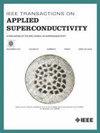Basic Design of REBCO Insert Coil of 33 T Cryogen-Free Superconducting Magnet
IF 1.7
3区 物理与天体物理
Q3 ENGINEERING, ELECTRICAL & ELECTRONIC
引用次数: 0
Abstract
A 33 T cryogen-free superconducting magnet (33 T-CSM) is under development. The 33 T-CSM consists of a REBCO insert coil and Nb3Sn/NbTi outsert coils. The REBCO insert coil is designed to generate 19 T in the external field of 14 T. The REBCO insert coil is composed of stacked 64 single pancake coils wound with two bundled REBCO tapes. The inner and outer diameters of the REBCO insert coil are 68 mm and 295 mm, respectively. The REBCO coil is impregnated with epoxy resin for conduction cooling. To prevent delamination of the superconducting layer by thermal stress, the fluorine-coated polyimide tape is co-wound with REBCO tapes and to prevent degradation of superconductivity by electromagnetic stress, reinforcing tape is also co-wound. According to 2D-FEM, it is shown that the circumferential strain33t无低温超导磁体REBCO插入线圈的基本设计
一种33t无低温超导磁体(33t - csm)正在研制中。33 T-CSM由REBCO插入线圈和Nb3Sn/NbTi引出线圈组成。REBCO插入线圈设计为在14 T的外场中产生19 T, REBCO插入线圈由堆叠的64个单煎饼线圈组成,并缠绕着两条捆扎的REBCO胶带。REBCO插入线圈的内径和外径分别为68 mm和295 mm。REBCO线圈浸渍了用于传导冷却的环氧树脂。为了防止超导层因热应力而分层,氟涂层聚酰亚胺带与REBCO带共缠绕,为了防止电磁应力导致超导性退化,增强带也共缠绕。通过二维有限元分析可知,在电磁力作用下,试件的周向应变ϵθ为0.29%。二维有限元分析结果还表明,应力集中发生在线圈与母线的连接处,以及REBCO胶带的宽端。本文将介绍嵌套线圈的基本设计和有限元分析结果。
本文章由计算机程序翻译,如有差异,请以英文原文为准。
求助全文
约1分钟内获得全文
求助全文
来源期刊

IEEE Transactions on Applied Superconductivity
工程技术-工程:电子与电气
CiteScore
3.50
自引率
33.30%
发文量
650
审稿时长
2.3 months
期刊介绍:
IEEE Transactions on Applied Superconductivity (TAS) contains articles on the applications of superconductivity and other relevant technology. Electronic applications include analog and digital circuits employing thin films and active devices such as Josephson junctions. Large scale applications include magnets for power applications such as motors and generators, for magnetic resonance, for accelerators, and cable applications such as power transmission.
 求助内容:
求助内容: 应助结果提醒方式:
应助结果提醒方式:


